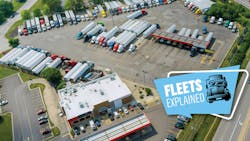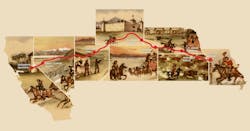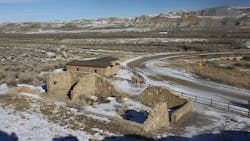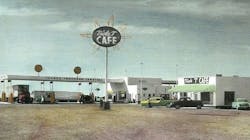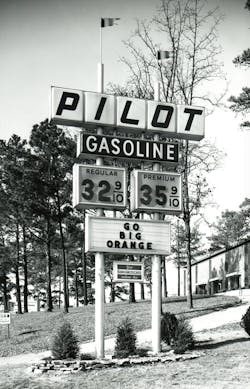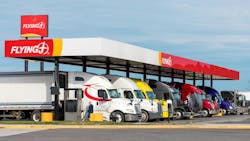Key takeaways:
- Truck stops originated from the Pony Express in the 1860s and evolved alongside the trucking industry after WWII.
- The establishment of the Interstate Highway System in the 1950s fueled the growth of truck stops, enhancing their facilities and services.
- Today, over 2,500 truck stops in the U.S. provide amenities like WiFi and electronic payments, meeting the diverse needs of truck drivers and travelers.
This is part of FleetOwner's Fleets Explained, a Trucking 101 series to break down aspects of the trucking and fleet management industries. You can read more from the series, launched in May 2024, at fleetowner.com/fleets-explained. To submit topic ideas, clarifications, and corrections, email [email protected].
From the Wild West to the aftermath of World War II to today, truck stops have grown from small watering holes to corporate networks that keep the men and women who move America's goods fueled, fed, rested, and more.
Today’s travel centers provide parking, fueling, food, and other amenities. But this wasn’t always the case. Truck stops have evolved alongside the trucking industry and the Interstate Highway System. This Fleets Explained entry will walk through the history of truck stops and how these oases for truck drivers have changed and improved over the years.
1860s: Wild West origins
While semi trucks as we know them today didn’t appear until the 1920s, the origins of truck stops link back to the Pony Express, an early American mail service in which riders and horses carried mail on routes between Missouri and California.
According to the National Park Service, the Pony Express had over 190 Pony stations that offered respite for riders. At these stations, riders could rest, switch out horses, trade for supplies, and more. These stations were positioned 5-20 miles apart.
These stations modeled what the future of truck stops would eventually look like.
1860s-1920s: Pony stations recycled
After the end of the Pony Express, Pony stations were repurposed as stage stations for travelers using stagecoaches. Like with Pony stations, stage stations allowed travelers to switch out tired horses for new ones to continue their journeys faster. A home station would also provide food and sometimes lodging, while swing stations only offered fresh horses.
1940s: Trucking booms after WWII
The first semi trucks were manufactured in the U.S. in the 1920s. But the trucking industry really took off in the wake of WWII. According to NATSO, which was founded as the National Association of Truck Stop Operators, the economic boom after the war also grew the trucking industry, which increased the need for better, more vast infrastructure across the U.S. as well as more truck stops.
During this time, truck stops became more prominent in the U.S. According to Bloom Services, this is when truck stops began offering additional services, such as showers, laundry facilities, and sleeping quarters.
See also: Fleets Explained: History of the 7 major heavy-duty truck manufacturers in the U.S.
1950s-1960s: Eisenhower champions interstate changes
During his administration, President Dwight D. Eisenhower focused on building a highway system across the U.S. You can read more about Eisenhower’s efforts in this Fleets Explained article. But essentially, after witnessing Germany’s highway system during the war, Eisenhower knew the U.S. would benefit from a similar system. Once he became president, Eisenhower’s administration championed this cause, which led to the Federal Aid Highway Act of 1956, and the Interstate Highway System was created.
The creation of the Interstate Highway System began the golden age of truck stops that continued into the 1960s, ‘70s, and ‘80s. Larger truck stops were built with more sophisticated offerings, including restaurants, convenience stores, and more.
1960s-1980s: Massive growth of truck stops and brands
In 1960, NATSO was established. The growth of truck stops across the U.S., especially after the Federal Aid Highway Act of 1956, prompted the need for such an association.
During this time, truck stop franchises began to emerge, such as:
- Amoco: Founded in 1889 and began creating truck stops in the 1950s.
- Speedway: Founded in 1959. The company was bought by 7-Eleven in 2021.
- Love’s Travel Stops: Founded in 1962.
- TravelCenters of America: Established in 1972 as Truckstops of America.
- Pilot Company: Opened its first truck stop in 1981.
In the 1980s, truck stops began appealing to more than just truck drivers. This rebrand as travel centers drew in RVs, four-wheelers, and eventually passenger cars on longer trips. This shift saw many truck stops also add gift shops, movie theaters, and more to their facilities.
2025: Truck stops today
Today, there are more than 2,500 truck stops across the U.S. While many have rebranded as travel centers, others still appeal primarily to truck drivers and offer a range of amenities and technology. Each year, Trucker Path ranks the top truck stops in the U.S. according to the truck drivers who use the Trucker Path app. You can read more about the 2025 rankings here.
In addition to the other amenities truck stops have offered over the years, modern truck stops now focus on technology as well. This includes WiFi, electronic payment options, phone charging stations, and more.
The modern truck driver today also expects more out of truck stops. Here are some of the amenities truck drivers care about, according to CloudTrucks:
- Truck parking: One of the most important offerings, if not the most important, of a truck stop is its parking facilities. The number of spaces available varies at each truck stop, and truck stops with higher numbers of spaces are preferable among drivers. Some truck stops allow parking reservations, which is great for drivers’ ease of mind.
- Safety: Not only do drivers have to worry about their own safety on the road but also the safety of their cargo. Truck stops that are well-lit and have surveillance systems offer drivers a greater sense of security.
- Healthy food: Eating healthy on the road can be difficult. It’s important for many truck drivers to have healthy options at truck stops, whether through convenience stores or restaurants.
- Hygiene options: Living on the road can be challenging. Truck stops that offer clean bathrooms, showers, and laundry services will stand out to drivers.
- Technology: As mentioned above, truck stops with upgraded technology and that offer WiFi, electronic payment options, and charging stations will best support truck drivers.
- Pet-friendly: While not applicable to every truck driver, many travel with pets. Those drivers will seek out truck stops that have dog parks, washes, etc.
About the Author

Jenna Hume
Digital Editor
Digital Editor Jenna Hume joined FleetOwner in November of 2023 and previously worked as a writer in the gaming industry. She has a bachelor of fine arts degree in creative writing from Truman State University and a master of fine arts degree in writing from Lindenwood University. She is currently based in Missouri.
